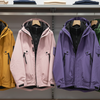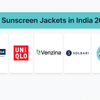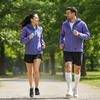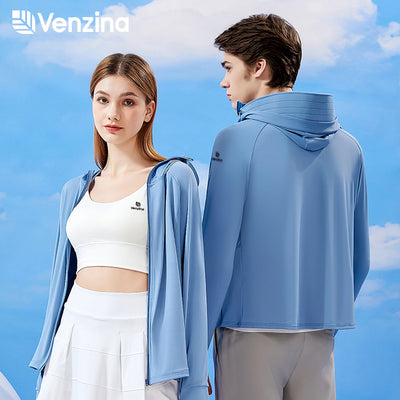2025 Guide to Choosing the Best Rainwear Fabrics for Monsoon
- by IN Venzina

Rainwear materials shape every monsoon experience in 2025. Polyester stands out as the top choice, offering durability and reliable water resistance for daily use. People want raincoats that protect and feel comfortable, especially with unpredictable weather. Nearly half of commuters look for tough fabrics, while many shoppers like eco-friendly options. Venzina’s raincoat collection, including mens raincoat and womens raincoat, combines stylish designs with practical features. Breathability and comfort matter most for families, making these materials ideal for city travel and outdoor adventures.
Key Takeaways
-
Polyester is the top choice for rainwear in 2025 due to its durability and water resistance.
-
Commuters should look for lightweight raincoats made from polyester blends for comfort and quick drying.
-
Nylon offers excellent durability, making it ideal for frequent wear in raincoats.
-
For outdoor activities, choose rainwear with breathable membranes to stay dry and comfortable.
-
Gore-Tex provides high waterproofness and breathability, perfect for heavy rain and long commutes.
-
Blended synthetics combine nylon and polyester for effective waterproofing and easy maintenance.
-
Always check the waterproof rating of rainwear to ensure it meets your needs for heavy rain.
-
Regularly clean and reproof your rainwear to maintain its waterproof capabilities and longevity.
Quick Picks
City Commute
Commuters in the city need rainwear that stands up to sudden showers and keeps them comfortable during busy mornings. Experts recommend three top rainwear materials for this purpose:
-
Polyester blends offer water resistance, quick drying, and easy care. They suit people who want a lightweight option for daily use.
-
Nylon provides durability and dries fast, making it ideal for raincoats that see frequent wear.
-
Linen stands out for breathability and moisture-wicking, helping commuters stay cool in humid conditions.
Venzina’s Men’s Raincoat collection features robust polyester and nylon designs. These raincoats come with hoods for extra coverage and classic colors like Black, making them a smart choice for city travel. Explore the Venzina Men’s Raincoat category for more options.
Tip: Choose a raincoat with a packable design so you can easily store it in your bag when the sun comes out.
Daily Travel
People who travel daily, whether to school or work, need rainwear that balances comfort and protection. Venzina offers several lightweight waterproof options for women, perfect for heavy rain and unpredictable weather:
-
Lightweight Waterproof Women’s Raincoat in Army Green, Khaki, and Navy Blue. This raincoat includes a storage bag for easy carrying.
-
Lightweight Raincoat for Women in Khaki and Navy Blue with a playful white polka dot pattern. This style adds a fun touch to rainy days.
These raincoats start at ₹ 1,901.00 and combine style with reliable waterproofing. Shoppers can browse the Venzina Women’s Raincoat category to find the best fit for their daily routine.
Note: Look for rainwear materials that feel soft against the skin and offer enough room for layering on cooler mornings.
Hiking & Cycling
Outdoor enthusiasts need rainwear that performs well during hikes and cycling trips in the monsoon. The best options combine waterproofing with breathability and packability. Here’s a quick look at what matters most:
|
Feature |
Description |
|---|---|
|
Waterproofing with Breathability |
Advanced synthetic membranes keep water out while letting moisture escape, ensuring comfort during activity. |
|
Lightweight & Packable Options |
Designs fold easily and store compactly, offering convenience without sacrificing durability or coverage. |
Venzina’s raincoats use lightweight synthetic fabrics that support active movement and resist abrasion. These features make them suitable for both short rides and long treks.
Pro tip: Pick a raincoat with adjustable cuffs and a secure hood to stay dry and comfortable on the trail.
Rainwear Materials Comparison

Gore-Tex vs PU-coated
When people compare rainwear materials, Gore-Tex and PU-coated fabrics often come up first. Gore-Tex uses a special membrane with microscopic pores. This design keeps water out but lets sweat escape, so wearers stay dry and comfortable. Gore-Tex comes in several grades, like Gore-Tex Pro and Gore-Tex Active. Each grade promises high waterproofness and breathability. PU-coated fabrics also block water, but they do not use the same technology. PU coatings make the fabric thicker and less breathable.
-
Gore-Tex rainwear offers:
-
High waterproofness
-
Excellent breathability
-
Lightweight feel
-
Long-lasting durability
-
-
PU-coated rainwear provides:
-
Reliable waterproofing
-
Moderate breathability
-
Slightly heavier feel
-
Good value for budget shoppers
-
Venzina raincoats use lightweight synthetic fabrics inspired by these technologies. They balance waterproof protection and comfort, making them suitable for city commutes and outdoor adventures.
Here is a quick look at how these two rainwear materials compare in weight and durability:
|
Fabric Type |
Weight |
Durability |
|---|---|---|
|
Gore-Tex® |
Light |
High |
|
PU-Coated Nylon |
Light |
Moderate |
Tip: For heavy rain and long walks, choose a raincoat with a breathable membrane. It helps prevent overheating and keeps you dry inside and out.
Nylon vs Polyester
Nylon and polyester are two of the most popular rainwear materials. Both offer water resistance and quick drying, but they perform differently in real-world conditions. Polyester absorbs less water than nylon, so it dries faster after a downpour. Nylon, on the other hand, is known for its strength and longevity.
|
Fabric |
Water Absorption |
Drying Time |
|---|---|---|
|
Polyester |
≈0.4% of weight |
Very fast |
|
Nylon |
1.5–9% (24h) |
Fast |
Polyester stands out for its balance of water resistance, durability, and lightweight comfort. It resists wear and tear, stretches less, and keeps its shape over time. Many raincoats, including Venzina’s Women’s Lightweight Waterproof Raincoat, use polyester for these reasons. Shoppers appreciate the quick drying and easy maintenance.
Nylon offers outstanding strength and reliability. Lightweight nylon is water-resistant but may need extra treatment to become fully waterproof. Heavyweight nylon works well for heavy rain. Venzina’s Men’s Raincoat features nylon blends for added durability and protection.
-
Polyester:
-
Excellent water resistance
-
Quick drying
-
Maintains shape and effectiveness
-
Great value for money
-
-
Nylon:
-
Superior strength and longevity
-
Reliable for outdoor gear
-
Water-resistant, especially in heavier weights
-
Tip: For heavy rain and long walks, choose a raincoat with a breathable membrane. It helps prevent overheating and keeps you dry inside and out.
Nylon vs Polyester
Nylon and polyester are two of the most popular rainwear materials. Both offer water resistance and quick drying, but they perform differently in real-world conditions. Polyester absorbs less water than nylon, so it dries faster after a downpour. Nylon, on the other hand, is known for its strength and longevity.
|
Fabric |
Water Absorption |
Drying Time |
|---|---|---|
|
Polyester |
≈0.4% of weight |
Very fast |
|
Nylon |
1.5–9% (24h) |
Fast |
Polyester stands out for its balance of water resistance, durability, and lightweight comfort. It resists wear and tear, stretches less, and keeps its shape over time. Many raincoats, including Venzina’s Women’s Lightweight Waterproof Raincoat, use polyester for these reasons. Shoppers appreciate the quick drying and easy maintenance.
Nylon offers outstanding strength and reliability. Lightweight nylon is water-resistant but may need extra treatment to become fully waterproof. Heavyweight nylon works well for heavy rain. Venzina’s Men’s Raincoat features nylon blends for added durability and protection.
-
Polyester:
-
Excellent water resistance
-
Quick drying
-
Maintains shape and effectiveness
-
Great value for money
-
-
Nylon:
-
Superior strength and longevity
-
Reliable for outdoor gear
-
Water-resistant, especially in heavier weights
-
Note: For daily travel, polyester rainwear materials offer the best mix of comfort and protection. Nylon works well for those who need extra durability for outdoor activities.
PVC/Polyurethane
PVC and polyurethane (PU) are classic rainwear materials known for their waterproof ratings. PVC offers the highest waterproof protection, while PU provides a good balance of water resistance and eco-friendliness.
|
Material |
Waterproof Rating |
|---|---|
|
PU |
1,000–5,000 mm |
|
PVC |
10,000–30,000 mm |
PU raincoats break down more easily over time and use fewer harmful chemicals in production. PVC, while extremely waterproof, poses environmental challenges. It can release toxic chemicals and is hard to recycle.
-
PU rainwear:
-
More eco-friendly
-
Breaks down naturally
-
Good waterproof protection
-
-
PVC rainwear:
-
Maximum waterproofing
-
Persistent in the environment
-
Difficult to recycle
-
Venzina focuses on synthetic blends that avoid the drawbacks of PVC, offering raincoats that protect without harming the environment.
Pro tip: If you want strong waterproofing and care about the planet, PU-coated rainwear materials are a smart choice.
Wool/Wool-Blend
Wool stands out as a classic choice for rainwear materials, especially during the monsoon. People appreciate wool for its natural waterproof and wind-resistant qualities. Wool keeps wearers comfortable with its softness and breathability. Many choose wool raincoats for city walks or short commutes because the fabric feels cozy and warm.
However, wool has some challenges in heavy rain. Wool takes longer to dry after getting wet, and it can feel heavier than synthetic options. Wool-blend fabrics improve durability and performance, making them more practical for everyday use. These blends often use synthetic fibers to help the coat dry faster and last longer. Some users notice that wool blends may not breathe as well as pure wool, which matters when humidity rises.
Tip: Wool and wool-blend raincoats work best for light showers and cool mornings. For heavy downpours, consider a synthetic shell for quicker drying.
Silk/Linen
Silk and linen offer a unique approach to rainwear. Both materials feel light and breathable, making them comfortable for humid monsoon days. People who want a stylish raincoat sometimes pick silk or linen for their elegant look and soft touch.
Here’s a quick comparison of silk and linen for rainwear:
|
Material |
Breathability |
Water Resistance |
|---|---|---|
|
Silk |
High |
Low |
|
Linen |
High |
Low |
Silk and linen excel in breathability, so wearers stay cool even when the air feels sticky. These fabrics do not block water as well as synthetics or wool. Most silk or linen raincoats suit light drizzle or short trips outside. For heavy rain, users often layer these coats over water-resistant shells.
Note: Silk and linen rainwear materials add style and comfort, but they work best for mild weather or as a fashionable layer.
Blended Synthetics
Blended synthetics have become the go-to choice for monsoon rainwear. Manufacturers often combine nylon and polyester to create raincoats that resist water, dry quickly, and last through many seasons. These rainwear materials offer high waterproof ratings, sometimes reaching 10,000 to 20,000 mm. People like blended synthetics for their lightweight feel and easy maintenance.
Nylon and polyester blends feature breathable membranes and fully taped seams. These details keep water out while letting sweat escape, which helps users stay comfortable during long commutes or outdoor activities. Many choose these raincoats for their cost-effectiveness and durability. Venzina’s raincoat collection uses these advanced blends to deliver reliable protection and style for every monsoon need.
Pro tip: For the best balance of waterproofing, breathability, and value, blended synthetic rainwear materials are a smart pick for Indian monsoon commuters and travelers.
How to Evaluate
Waterproof Ratings
Waterproof ratings help shoppers understand how well rainwear materials keep water out. Manufacturers use the hydrostatic-head test to measure this. They place a column of water over the fabric and see how much pressure it takes before water leaks through. A higher rating means better protection in heavy rain.
|
HH Grading Scale (mm) |
Best Used In Weather Conditions |
|---|---|
|
1,500mm to 5,000mm |
Light to average: rain showers, light snow |
|
5,000mm to 10,000mm |
Moderate: steady rain, snowfall |
|
10,000mm to 40,000mm+ |
Extreme: heavy rain, snowstorms |

Industry standards set minimums for waterproof jackets. A rating of 1,500mm works for light rain. Jackets with 5,000mm ratings suit snow and light rain. For extended heavy rain, look for 10,000mm or higher. Some high-performance jackets reach 30,000mm, perfect for extreme weather.
Rainwear often features DWR (Durable Water Repellent) coatings. DWR makes the surface hydrophobic, so water beads up and rolls off. Many brands now use PFC-free DWR for eco-friendliness. Seam-sealing is also key. Taped or welded seams stop water from sneaking through stitch lines.
Tip: Always check the waterproof rating and look for DWR and seam-sealing in product details. These features make a big difference during the monsoon.
Breathability
Breathability keeps rainwear comfortable, especially in humid monsoon weather. Fabrics with waterproof membranes block rain but let sweat vapor escape. This helps prevent that sticky, clammy feeling inside the jacket.
|
Material Type |
Breathability Feature |
|---|---|
|
Waterproof membranes |
Block rain, allow sweat vapor to escape |
A comfortable fit also matters. Raincoats should allow air to circulate, keeping clothes dry and preventing a vacuum build-up.
|
Raincoat Fit |
Breathability Importance |
|---|---|
|
Comfortable fit |
Allows air circulation, keeps clothes dry |
People often find breathability more important than fit. If a jacket traps heat and moisture, it feels uncomfortable fast. Breathable rainwear materials help users stay cool and dry, even when the weather turns muggy.
Note: For city commutes and outdoor activities, choose rainwear with breathable membranes and a relaxed fit.
Durability
Durability means a raincoat can handle regular use, rough weather, and the occasional scrape. Manufacturers test fabrics for abrasion and tear resistance. Some materials stand out for their toughness.
|
Material |
Durability Level |
Key Features |
|---|---|---|
|
Pertex Shield |
High |
Rhombus-shaped filaments, high abrasion and tear resistance |
|
DryVent |
Moderate |
Treated outer layer, some abrasion resistance |
|
Dyneema |
Very High |
High strength, lightweight, used in protective clothing |
|
Cordura |
Very High |
Excellent abrasion resistance, common in outdoor gear |
Rainwear materials like Cordura and Dyneema offer excellent durability for hiking and cycling. Pertex Shield provides strong resistance to tears and scrapes. DryVent suits daily travel with moderate durability. GSM (grams per square meter) and denier (fiber thickness) also indicate strength. Higher numbers mean tougher fabric.
Pro tip: For monsoon adventures, pick rainwear with high abrasion resistance and sturdy construction. It lasts longer and keeps you protected.
Fit & Features

Length & Silhouette
Rainwear fit can make all the difference during the monsoon. People often choose longer raincoats for full coverage, especially when walking through heavy rain. Long raincoats reach below the knee, protecting pants and shoes from splashes. Ponchos offer a quick solution for sudden showers. They slip on easily and feel light, making them perfect for students and commuters who want fast protection. Cyclists and hikers often prefer rain capes, which allow easy movement and shield more of the body.
Venzina’s raincoat collection includes options for every need. The Men’s Raincoat features a classic silhouette with a hood for extra coverage. Women’s Lightweight Waterproof Raincoat offers a modern cut, available in colors like Army Green, Khaki, and Navy Blue. These choices help users stay dry while expressing their style.
Tip: For city travel, a mid-length raincoat balances coverage and comfort. For outdoor adventures, a longer silhouette keeps you protected from head to toe.
Details
Small details can transform a raincoat from basic to essential. Adjustable hoods help shield the face from wind and rain. Multiple pockets provide space for phones, wallets, and keys, keeping essentials dry. Breathable fabrics prevent stickiness, especially in humid weather. Quick-drying materials ensure the coat feels comfortable after a downpour.
Venzina raincoats stand out with thoughtful features. Many designs include storage bags for easy carrying. Some styles offer playful patterns, like white polka dots on Navy Blue, adding a fun touch to rainy days. Eco-friendly options use recycled materials, appealing to shoppers who care about sustainability.
|
Raincoat Type |
Key Features |
|---|---|
|
Packable Rain Jacket |
Lightweight, portable, folds into a small size, ideal for travel. |
|
Poncho |
Simple, effective, made from waterproof fabric, easy to wear, often includes a hood. |
|
Long Raincoat |
Provides full coverage, often has adjustable hoods and multiple pockets. |
|
Stylish Printed Raincoat |
Variety of patterns, allows personal expression even in rainy weather. |
|
Breathable Rain Jacket |
Designed for active lifestyles, allows sweat to escape while keeping rain out. |
Here’s a look at popular raincoat features for monsoon wear:
Note: Look for raincoats with adjustable cuffs and secure hoods. These features keep water out and add comfort during the monsoon.
Packability
Packability matters for anyone on the go. Travelers and commuters want rainwear that fits easily into a bag or backpack. Modern raincoats use lightweight materials that fold into compact pouches. Some designs even pack into their own pocket, saving space and making storage simple. Integrated straps allow users to carry raincoats around the waist, freeing up hands for other tasks.
Venzina’s Women’s Lightweight Waterproof Raincoat comes with a storage bag, making it easy to carry and store. These packable options suit students, professionals, and outdoor enthusiasts who need reliable protection without extra bulk.
-
Lightweight jackets offer convenience for daily travel.
-
Packable raincoats provide practical solutions for unpredictable weather.
-
Compact designs help users stay prepared without weighing down their luggage.
Pro tip: Choose a raincoat that packs down small. You’ll always have protection ready, whether you’re heading to class, work, or a weekend adventure.
Care & Longevity
Washing
Rainwear materials need regular care to stay waterproof and comfortable through the monsoon. Many people think washing a raincoat is tricky, but simple steps help keep it in top shape. He should always check the care label before cleaning. Most raincoats work well with gentle washing methods.
Here are some easy ways to wash rainwear:
-
Use a mild detergent made for waterproof clothes. Harsh chemicals can damage the fabric and reduce water resistance.
-
Wash by hand in cold or warm water. Fill a basin, add detergent, gently agitate, soak, rinse, and squeeze out excess water.
-
For machine washing, set the cycle to delicate or gentle. Use warm or cold water and a specialized detergent. Add a second rinse to remove all soap.
-
Spot clean small stains with a wet cloth and gentle soap. Rinse thoroughly to avoid residue.
-
Never use fabric conditioners. They can block the waterproof membrane and reduce breathability.
-
Hang the raincoat to air dry. Avoid direct sunlight or heat sources, which can weaken the fabric. If the care label allows, use a dryer on low heat to help reactivate the water-repellent finish.
Many people forget to rinse thoroughly, leaving detergent behind. This mistake can make the raincoat less effective. He should always make sure the jacket is completely clean before drying.
Tip: Regular cleaning keeps rainwear fresh and helps maintain its waterproof rating. Always follow the manufacturer’s instructions for best results.
Reproofing
Even the best rainwear materials lose their water-repellent finish over time. Reproofing restores the Durable Water Repellent (DWR) coating, so water beads up and rolls off the surface. She can tell it’s time to reproof when rain stops forming droplets and starts soaking into the fabric.
Here’s how to reproof rainwear:
-
Clean the jacket first. Dirt and oils block the DWR treatment.
-
Use a spray-on or wash-in waterproofing product designed for technical fabrics. Apply evenly to the outer surface.
-
After treatment, tumble dry on low heat if the care label allows. Heat helps activate the DWR finish.
-
Test the jacket by sprinkling water on it. If droplets form, the reproofing worked.
Common mistakes include skipping the cleaning step or using the wrong product. He should never use wax or oil-based treatments on modern rainwear materials. These can clog the fabric and reduce breathability.
Note: Reproofing every few months keeps rainwear performing well during the monsoon. She should always check for signs of wear and treat the jacket before heavy rain arrives.
A little care goes a long way. With proper washing and regular reproofing, rainwear stays waterproof, breathable, and ready for every monsoon adventure.
Buying Checklist
Budget Tiers
Choosing the right rainwear starts with knowing your budget. People often wonder how much they should spend for reliable protection during the monsoon. Rainwear prices in 2025 range from affordable disposable options to premium, long-lasting coats. The table below shows typical price points for different types of rainwear:
|
Product Description |
Price (₹) |
|---|---|
|
HI White Plastic Raincoat, Size: S and M |
195 /onwards |
|
Hood 5 color Plastic Raincoat, Size: free size |
72 /Piece |
|
Eva Rain coat 150Grm |
52 /Piece |
|
XL Unisex WATERPROOF RAINCOAT DISPOSABLE |
13 /Piece |
|
XL Unisex Disposable Ball Shape Raincoat |
25 /Piece |
|
Disposable Ball Shape Raincoat, Size: Small |
35 /Piece |
|
Plain Full Sleeves Rain Coat |
280 /Piece |
|
Unisex Plastic Raincoat |
75 /Piece |
|
Dinesh Rainwear PVC Fantasy Rain Suit, Size: XL & XXL |
300 /Piece |
|
Plastic Raincoat |
175 /Piece |
|
Unisex XL Plastic Raincoat |
47 /Piece |

People who choose budget rainwear get solid protection for a low price. Many entry-level options offer double-layer protection and taped seams. These features keep water out and add value. However, shoppers who want more comfort and style often look for mid-range or premium raincoats. Venzina’s raincoat collection starts at ₹ 1,901.00, offering stylish designs and durable materials for men and women. Explore Venzina Men’s Raincoat and Venzina Women’s Raincoat for options that balance quality and price.
Tip: Set your budget first, then compare features like waterproof ratings, breathability, and packability. This helps you find the best value for your needs.
Scenario Guide
People buy rainwear for different reasons. Some need a coat for daily commutes, while others want protection for travel or outdoor sports. The decision tree below helps shoppers choose the right raincoat for their lifestyle:
Rainwear Decision Tree
-
City Commute:
-
Needs: Quick-dry, lightweight, packable
-
Best pick: Polyester or nylon blends
-
Try: Venzina Men’s Raincoat for classic style and coverage
-
-
Daily Travel (School/Work):
-
Needs: Comfort, easy care, stylish look
-
Best pick: Lightweight waterproof raincoat
-
Try: Venzina Women’s Raincoat with storage bag and trendy colors
-
-
Sport & Adventure (Hiking/Cycling):
-
Needs: High breathability, abrasion resistance, secure fit
-
Best pick: Blended synthetics with taped seams
-
Try: Venzina raincoats designed for active movement
-
People who travel often should look for rainwear that packs down small and dries quickly. Commuters benefit from coats with hoods and adjustable cuffs. Outdoor enthusiasts need tough fabrics that breathe well and resist wear.
Note: Always match your raincoat to your main activity. The right material and features make every monsoon day easier.
People choose rainwear materials based on their needs and budget.
-
Polyester and nylon suit daily commuters and students who want affordable, water-resistant jackets.
-
Gore-Tex and eVent work best for hikers and cyclists who need durability and breathability.
-
PU-coated fabrics and microfiber offer flexible options for travelers.

He should look for sealed seams, DWR coating, and quick-drying fabrics. She can layer lightweight clothes and pick darker colors for easy care. Venzina’s raincoat collection gives everyone stylish, practical choices for the monsoon.
FAQ
What’s the difference between waterproof and water-repellent rainwear?
Waterproof rainwear materials block water under pressure and feature sealed seams. Water-repellent jackets use a DWR coating that sheds light rain. Heavy downpours may soak through water-repellent fabrics.
Is Gore-Tex worth it for daily city commuting in India?
Gore-Tex offers high waterproof ratings and breathability. He finds it ideal for long commutes or unpredictable monsoon weather. For short trips, polyester or nylon rainwear provides good value and comfort.
Nylon or polyester—which lasts longer for monsoon use?
Nylon stands out for strength and durability. Polyester resists stretching and dries faster. She chooses nylon for outdoor adventures. He prefers polyester for daily travel and easy care.
How often should someone reapply DWR to a raincoat?
She should reapply DWR every few months or when water stops beading on the surface. Regular washing and reproofing keep rainwear materials performing well during the monsoon.
What features matter most for hot, humid monsoon weather?
Breathable rainwear, lightweight fabrics, and adjustable hoods help users stay cool and dry. He looks for quick-drying materials and packable designs for comfort during humid days.
Can someone machine wash a raincoat without damaging it?
He can machine wash most raincoats using a gentle cycle and mild detergent. Always check the care label first. Avoid fabric softeners, which may block waterproof membranes.
Are blended synthetics better for hiking and cycling in the monsoon?
Blended synthetics combine waterproof ratings, breathability, and durability. She finds these rainwear materials ideal for hiking and cycling. Taped seams and lightweight construction add extra protection and comfort.





